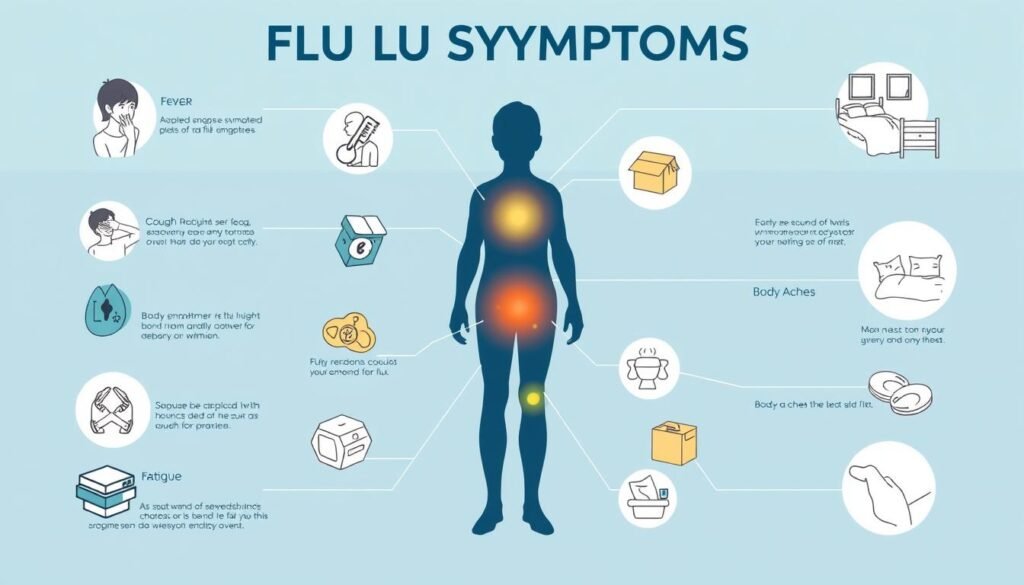Did you know the flu leads to 140,000 to 810,000 hospitalizations each year in the U.S.? Knowing flu symptoms is key for quick diagnosis and treatment. Every flu season, millions get sick, affecting health systems and communities a lot. Spotting flu virus symptoms early helps protect your health.
In this article, you’ll learn about flu symptoms, how to spot them, and why quick action is important. The flu can hit anyone, young or old. Knowing what to look for is your best defense.
Key Takeaways
- Flu symptoms can vary widely but often include fever, cough, and body aches.
- Recognizing symptoms early can lead to better management of the illness.
- Children and adults may experience different flu symptoms and severity levels.
- Timely treatment options can help alleviate flu symptoms and reduce complications.
- Preventive measures, such as vaccination, can significantly lower the risk of infection.
Understanding the Flu Virus
The flu virus is a big worry for public health. It causes outbreaks every year. This virus changes often, leading to different types of flu. Knowing about these viruses helps us understand their impact on our health.
Influenza is divided into four types: A, B, C, and D. Types A and B are the most common. They cause seasonal epidemics. Type A viruses can be very severe and affect many species. Type B viruses are less severe and mainly hit humans.
Type C viruses cause milder symptoms. Type D viruses mostly affect cattle and rarely infect humans.
The flu virus spreads through respiratory droplets when someone sneezes, coughs, or talks. You can also get it by touching contaminated surfaces and then your face. This makes it important to practice good hygiene, even more so during flu season.
Knowing about the different flu types and their effects is key. It shows why flu vaccinations and public health efforts are so important. Being aware of the flu virus helps us take steps to prevent it.
| Flu Type | Description | Severity | Hosts |
|---|---|---|---|
| Type A | Causes seasonal epidemics and can infect different species | Severe | Humans and animals |
| Type B | Primarily impacts humans; generally less severe | Moderate | Humans |
| Type C | Causes mild respiratory illness | Mild | Humans |
| Type D | Primarily affects cattle and does not infect humans | Not applicable | Cattle |
Flue Symptoms: What to Look For
It’s important to know the typical flu symptoms to manage and understand the flu well. The flu symptoms start suddenly and can vary in how bad they are. You might have mild symptoms or severe ones that could lead to complications.
Common Signs of Flu
Flu symptoms usually include:
- Fever or chills
- Sore throat
- Cough
- Body aches
- Fatigue
These symptoms usually show up one to four days after you get infected. It’s key to watch these signs closely to tell them apart from other respiratory infections.
Understanding Severity
Flu symptoms can be mild or severe. The severity of the flu can hit hard on certain groups, like the elderly or those with weak immune systems. In some cases, flu can cause serious problems like pneumonia. Knowing how severe it can be is important for getting the right treatment on time.

By knowing these signs and understanding how severe the flu can be, you can take steps to protect your health during flu season.
Early Signs of Influenza
Knowing the early signs of influenza is key to managing the illness well. Symptoms often start suddenly. A high fever is a common first sign.
Along with fever, you might feel extremely tired. This fatigue can make it hard to do everyday tasks. A sore throat is another early symptom. It can range from mild to very painful.
Feeling achy all over is also a sign. It means your body is fighting the virus. Spotting these signs early helps you get the right care and avoid spreading the virus.

Knowing when you have the flu helps you tell it apart from a cold. A cold usually develops slowly, but the flu hits fast. Being aware of these signs can help you get medical help sooner.
Common Flu Symptoms in Adults
Flu symptoms in adults can vary a lot. It’s important to know how severe and different they can be. This helps in identifying and managing the flu better.
How Symptoms Differ by Age
In adults, common flu symptoms include:
- High fever
- Severe muscle pain
- Headaches
- Fatigue
- Coughing and sore throat
Age can change how flu symptoms show up. For example, older adults might not have as high a fever but feel much more tired and confused. This makes it harder to tell if they have the flu. Kids, on the other hand, often get more stomach problems like vomiting and diarrhea, which is less common in adults.
| Symptom | Adults | Older Adults | Children |
|---|---|---|---|
| High Fever | Common | Less Visible | Varies |
| Muscle Pain | Severe | Substantial | Moderate |
| Headaches | Frequent | Possible | Less Common |
| Fatigue | Prominent | Often Severe | Varies |
| Coughing | Common | Varies | Common |

Common Flu Symptoms in Children
It can be hard to tell if a child has the flu. They might not say how they feel. Look out for signs like fever, chills, and a sore throat.
Flu can also cause stomach problems. Kids might throw up or have diarrhea. This can make them dehydrated, so it’s important to keep them hydrated.
Another sign is if a child gets irritable. They might be more cranky, not want to eat, or want to be held a lot. Paying attention to these changes can help you catch the flu early.

Knowing the flu symptoms in kids can help them get better faster. When flu season comes, watch for these signs to get them the care they need.
| Flu Symptoms | Description |
|---|---|
| Fever | Elevated body temperature, often above 100°F. |
| Sore Throat | Discomfort or pain in the throat, which gets worse when swallowing. |
| Vomiting | Throwing up, which can cause dehydration. |
| Diarrhea | Loose or watery stools, which can be a problem. |
| Increased Irritability | Being more cranky and clingy than usual, needing more attention. |
By knowing these signs, parents can help their kids stay healthy during flu season.
Specific Influenza Symptoms to Monitor
It’s important to know the signs of the flu to manage it well. Look out for sore throat symptoms and body aches, including flu fatigue. Spotting these early can help avoid more problems and speed up recovery.
Sore Throat and Cough
Sore throat is a common flu symptom, often with fever or tiredness. It can cause a long-lasting cough. Treating sore throat early helps you rest better and recover faster.
Body Aches and Fatigue
Body aches are a big part of the flu, and they can be quite strong. These aches and tiredness make it hard to do everyday things. It’s key to understand how these symptoms affect you. By taking care of body aches and resting enough, you can get back to normal sooner.

Associated Symptoms of the Flu
It’s important to know all the symptoms of the flu to manage it well. While we often talk about respiratory symptoms, don’t forget about gastrointestinal ones. Symptoms like nausea, vomiting, and diarrhea can happen in both kids and adults.
Gastrointestinal Symptoms
Knowing about flu symptoms in your stomach can help you deal with it better. Here are the main ones to watch out for:
- Nausea: A feeling of sickness that may come with other flu symptoms.
- Vomiting: This can be severe and lead to dehydration if not handled right.
- Diarrhea: Frequent, loose stools that can make you feel even worse.
- Abdominal pain: Cramping or discomfort in the stomach area, often due to the virus.
These symptoms might mean you’re facing flu complications. Keeping an eye on how you feel can help decide if you need more medical help. If your stomach problems don’t get better or get worse, it’s best to see a doctor.
| Symptom | Common in Adults | Common in Children |
|---|---|---|
| Nausea | Yes | Yes |
| Vomiting | Less common | More common |
| Diarrhea | Occasionally | Frequently |
| Abdominal pain | Sometimes | Often |
When to Seek Medical Attention
Knowing when to get medical help for flu symptoms is key to staying healthy. There are clear signs that mean you should see a doctor right away. These include:
- Difficulty breathing
- Persistent chest pain
- Confusion or disorientation
- Severe or persistent vomiting
- Fever that does not improve with over-the-counter medications
People at high risk, like the elderly or those with health issues, should watch out closely. Getting medical help quickly can prevent serious flu complications. These complications can cause even bigger health problems.
Knowing these symptoms and when to get help can greatly improve your recovery. If you think you have severe flu symptoms, don’t wait to see a doctor.
| Symptoms | When to Seek Medical Attention |
|---|---|
| Difficulty Breathing | Immediate care is essential. |
| Chest Pain | If persistent, seek help right away. |
| Confusion | Contact a healthcare provider immediately. |
| Severe Vomiting | Consult a doctor for severe cases. |
| Persistent Fever | If it does not respond to treatment. |
Flu Treatment Options
When you get the flu, you want to feel better fast. There are many ways to treat it. Knowing the difference between over-the-counter (OTC) remedies and prescription medications can help you manage your flu better.
Using a mix of OTC flu remedies and prescription antiviral medications can make a big difference. They can help shorten how long you’re sick and make your symptoms less severe.
Over-the-Counter Remedies
OTC flu remedies can really help you feel better. They include:
- Pain relievers like ibuprofen and acetaminophen to lower fever and ease body aches.
- Decongestants to clear up your nose and make breathing easier.
- Cough suppressants to cut down on coughing and irritation.
- Antihistamines to stop runny noses or sneezing.
Make sure to read the label and talk to your doctor if you have any questions. This is important if you have other health issues or are taking other medicines.
Prescription Antiviral Medications
If your flu symptoms are bad or you’re at risk for serious problems, your doctor might give you antiviral meds. These can make your flu less severe and help you get better faster if you start them early. Some common ones are:
- Oseltamivir (Tamiflu)
- Zanamivir (Relenza)
- Peramivir (Rapivab)
Talk to your doctor about what’s best for you. Starting treatment early can help you recover faster.
| Treatment Type | Examples | Notes |
|---|---|---|
| OTC Remedies | Pain relievers, decongestants, cough suppressants, antihistamines | Safe for most individuals; consult healthcare provider if unsure |
| Prescription Antivirals | Oseltamivir, Zanamivir, Peramivir | Best when started within 48 hours of symptoms; consult a doctor |
Effective Flu Prevention Strategies
It’s important to take steps to prevent the flu, even more so during peak flu season. You can lower your risk by getting vaccinated and practicing good hygiene. Here are some key ways to fight the flu virus.
The Role of Vaccines
The flu vaccine is a top way to fight flu infections. Health groups say getting vaccinated every year is key to staying safe from flu. The vaccine’s success can change each year, but it helps prevent serious cases and hospital stays. By getting vaccinated, you protect yourself and help keep your community healthy.
Vaccination is very important for people who are older or have health issues. They are more at risk for serious flu problems.
Hand Hygiene and Social Distancing
Good hand hygiene is a must for staying flu-free. Wash your hands with soap and water or use hand sanitizer, often. This is important after being in public or touching things that might be dirty. Also, try not to touch your face, like your eyes, nose, and mouth, to avoid spreading the virus.
Keeping a safe distance from others is also key. Try to stay at least six feet away from people, even in crowded places. This helps stop the flu from spreading through the air.
| Prevention Strategies | Description |
|---|---|
| Flu Vaccine | Annual vaccination to reduce infection and severity of flu. |
| Hand Hygiene | Frequent hand washing and use of hand sanitizers. |
| Social Distancing | Maintaining distance from others to minimize exposure. |
| Avoiding Crowds | Staying away from crowded places during flu season. |
By following these tips, you can boost the flu vaccine’s power and keep yourself and your family safe during flu season.
Flu Diagnosis: What to Expect
When you have flu symptoms, knowing how doctors diagnose the flu is key. At your doctor’s office, you’ll get a detailed check-up. This starts with looking at your health history. This helps the doctor understand your symptoms and any past health problems.
Next, a physical exam is done. Your doctor will look for signs like fever, cough, or body aches. These signs help figure out if you have the flu.
Testing for the flu might be needed. Doctors use different tests for this:
- Rapid influenza diagnostic tests (RIDTs): These tests give results in 30 minutes and spot certain virus strains.
- Polymerase chain reaction (PCR) tests: These tests are more accurate but take longer to get results.
- Viral culture: This method takes the longest but gives a clear diagnosis by growing the virus in a lab.
After the exam and tests, your doctor will talk to you about the results. Knowing what to expect can help you get medical help faster when you have flu symptoms.
Home Remedies for Flu Relief
When you have the flu, home remedies can help you feel better. Drinking lots of fluids keeps your body moist. Warm drinks like herbal teas or broths soothe your throat and give you nutrients.
Rest is key to getting better. Your body heals faster when you sleep well. Drinking fluids and eating nutritious foods like juices can boost your immune system.
Here are some natural ways to feel better:
- Ginger tea: It fights inflammation and eases sore throats and body aches.
- Honey: It soothes your throat and might fight off germs.
- Steam inhalation: It clears your nose and makes breathing easier.
- Saltwater gargle: It reduces throat swelling.
These remedies can help, but don’t forget to see a doctor if your symptoms get worse. Medical care is important for the right treatment.
| Home Remedy | Benefits |
|---|---|
| Ginger Tea | Reduces inflammation and soothes sore throat |
| Honey | Provides throat relief and has antimicrobial effects |
| Steam Inhalation | Clears nasal passages and eases breathing |
| Saltwater Gargle | Reduces throat inflammation |
Conclusion
Knowing the early signs of the flu is key to treating it well and avoiding serious problems. Symptoms like fever, cough, and body aches help you spot the flu early. This lets you get medical help fast.
Being aware of flu symptoms helps you take care of yourself during flu season. It’s not just about treating symptoms. It’s about knowing how to lessen the flu’s effect on your life. Your doctor is a great resource to help you stay safe during flu season.
Vaccination is a top way to prevent the flu. By getting vaccinated, you protect yourself and help your community stay healthy. Understanding the flu and getting vaccinated can make everyone healthier during flu season.



